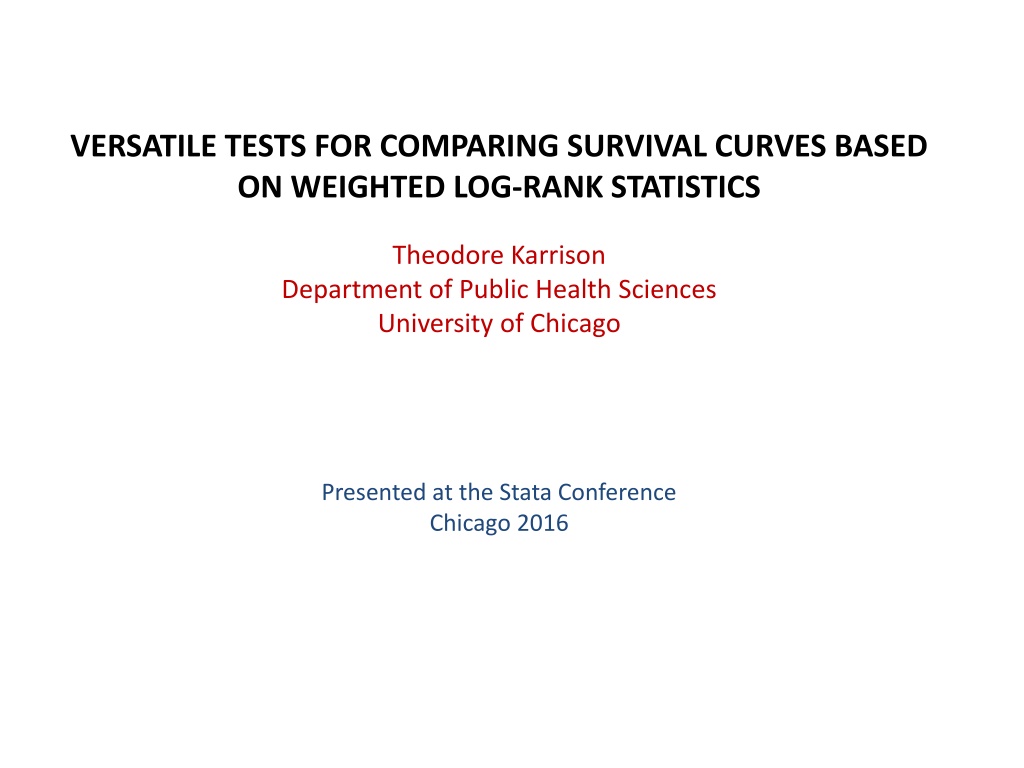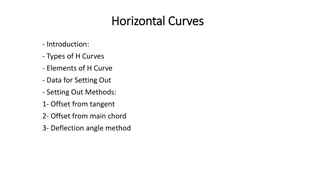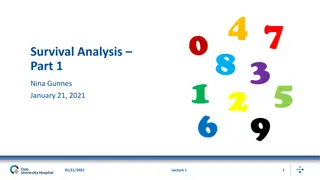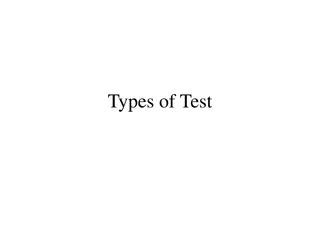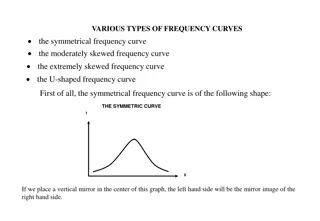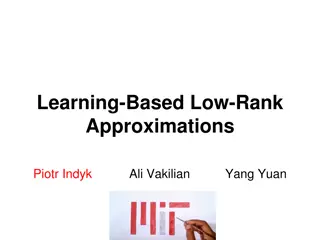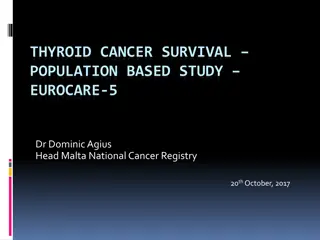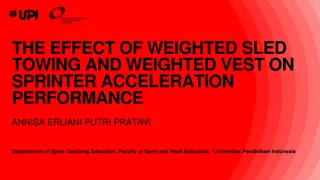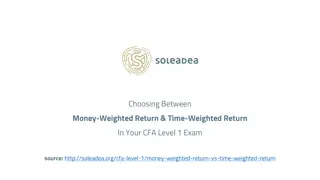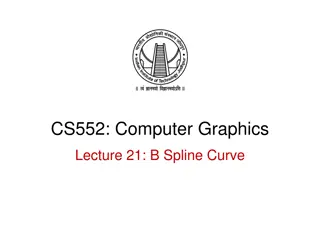Versatile Tests for Comparing Survival Curves Based on Weighted Log-Rank Statistics
Overview of various statistical tests for comparing survival curves beyond the traditional log-rank test. The focus is on weighted log-rank statistics sensitive to non-proportional hazards scenarios, with examples and methodologies discussed. These tests aim to provide more nuanced insights into differences across survival curves, particularly in clinical trials and medical research.
Uploaded on Oct 08, 2024 | 0 Views
Download Presentation

Please find below an Image/Link to download the presentation.
The content on the website is provided AS IS for your information and personal use only. It may not be sold, licensed, or shared on other websites without obtaining consent from the author. Download presentation by click this link. If you encounter any issues during the download, it is possible that the publisher has removed the file from their server.
E N D
Presentation Transcript
VERSATILE TESTS FOR COMPARING SURVIVAL CURVES BASED ON WEIGHTED LOG-RANK STATISTICS Theodore Karrison Department of Public Health Sciences University of Chicago Presented at the Stata Conference Chicago 2016
Motivation Evaluation of a Novel Rash Scale and a Serum Proteomic Predictor in a Randomized Phase II Trial of Sequential or Concurrent Cetuximab and Pemetrexed in Previously Treated Non-small Cell Lung Cancer (NSCLC) -- Maitland, Levine, et al. (BMC Cancer, 2014) Statistical analysis: In the comparison of overall survival between treatment arms, there was evidence of non-proportional hazards, and therefore the Prentice-Wilcoxon test (which assigns greater weight to earlier time-points) rather than the log-rank test is presented.
Kaplan-Meier Estimates of Overall Survival 1.00 Prentice-Wilcoxon p=0.045 0.75 0.50 0.25 0.00 0 6 12 18 24 Time (months) Blue: Sequential (n=20) Red: Concurrent (n=23) The large difference is hard to ignore, but should the p-value have been adjusted?
OUTLINE INTRODUCTION METHODOLOGY EXAMPLES SIMULATION STUDY SUMMARY
INTRODUCTION The log-rank (LR) test is perhaps the most commonly used nonparametric procedure for comparing two survival curves. Yields maximum power under proportional hazards (PH) alternatives. Survival Curves Exhibiting Proportional Hazards While PH often holds, this need not be the case. Survival curves may separate early and then converge, or may be similar initially and diverge later in time.
Several authors have therefore developed versatile tests based on combinations of weighted log-rank statistics that are more sensitive to non-PH alternatives. Fleming and Harrington (1991) considered the family of G statistics and their supremum versions. Lee, JW (1996) and Lee, S-H (2007) proposed tests based on the more extended family: G , JW Lee (1996) evaluated the maximum over four z-statistics derived from G0,0, G2,0, G0,2, and G2,2 tests, as well as their average. S-H Lee (2007) considered max(|Z1|,|Z2|), |Z1+Z2|/2, and (|Z1|+|Z2|)/2) where Z1 and Z2 are z-statistics obtained from G1,0 and G0,1 tests, respectively.
Z In this talk we will focus on = max(|Z1|,|Z2|,|Z3|), where Z1, Z2, and Z3 are Z-statistics obtained from G0,0, G1,0, and G0,1 tests, respectively. m G0,0 corresponds to the log-rank test while G1,0 is the Prentice-Wilcoxon statistic, more sensitive to early differences. G0,1 places more weight at the later time points and is therefore sensitive to late difference alternatives. The syntax for a Stata (College Station, TX) command to implement the method, verswlr, is described. The particular combination, G0,0, G1,0, and G0,1, should provide relatively good coverage across the range of likely possibilities, i.e., PH, early, and late difference alternatives. However verswlr allows the user to specify a different family of tests.
Key Issues: (1) We will have to allow for the fact that we are taking the maximum of three test statistics in order to maintain the type I error rate ( -level) at the nominal value (multiple comparisons issue). (2) How much power is sacrificed if PH does, in fact, hold? (3) How well does Zm perform compared to the more optimal test? (4) Implications for the design of clinical trials?
METHODOLOGY , The family of weighted logrank statistics can be expressed as G ) + n ( t ) ( ) t ( t ) ( t ) n n Y t Y t d N t d N t ( S ( S 0 = , 1 ) 1 n 2 1 ( 2 Y 1 ( 2 ( G t t (1) + ) ( ) ) ) Y Y Y 1 2 1 2 1 2 where is the number of patients in group i at risk at time t and ) (t Yi ) (t Ni is the number of failures in group i before or at time t. , = ?=1 G ? ??(?1? ?1?) over L event times If we let + n ( t ) ( ) t ( t ) ( t ) n n Y t Y t d N t d N t 0 = ( ) 1 n 2 1 ( 2 Y 1 ( 2 ( W K t Kl l + ) ( ) ) ) Y Y Y 1 2 1 2 1 2 (t ) Kl denote a weighted LR-statistic with weight , then . . .
= ( ) 1 G0,0 corresponds to : Equal weights Kl t G1,0 corresponds to : Greater weight at early time points ) ( ) ( = t S t Kl ( 1 ) ( = t S t Kl G0,1 corresponds to : Greater weight at later time points ) (t ) W (t ) W The covariance between and is K K l m ( ) + n 1 + Y + ( t ) ( ) t ( ) ( ) ( t ) ( ) 1 n n Y t Y t N t N t d N t N t = ( ) ( ) 1 1 2 1 2 1 2 1 2 K t K t (2) lm l m + + + ( ) ( ) ( ) ( ) ( ) ( ) 1 n Y Y Y t t Y Y t 0 2 1 2 1 2 1 2
Covariance formula (2) is convenient because Cov (G0,0,G1,0) = Var (G1/2,0) Cov (G0,0,G0,1) = Var (G0,1/2) Cov (G1,0,G0,1) = Var (G1/2,1/2) In general, ??? ??1,?1,??2,?2 = ???(?(?1+?2)/2,(?1+?2)/2) Therefore software routines that compute the variance of G , statistics and save the result can be used to calculate these covariance terms. For example, Stata: sts test treatment, fh(0.5,0) mat(u v) ( ) Z = has an asymptotic, trivariate normal distribution. 3 2 1 , , Z Z Z The p-value for Zm can be obtained by integrating under the trivariate normal density (Drezner, 1994).
verswlr command: stsetfailure_time, failure (indicator_var) verswlrvarname [if] [in] [, options] Options rho1(#) gamma1(#) -- Weights for first test rho2(#) gamma2(#) -- Weights for second test rho3(#) gamma3(#) -- Weights for third test Default values are (0 0), (1 0), and (0 1), respectively. Examples verswlr treatment - constructs max(G0,0, G1,0, and G0,1) verswlr treatment, rho2(2) gamma3(2) - constructs max(G0,0, G2,0, and G0,2)
EXAMPLES Example 1: GTSG Gastric Carcinoma Study (Stablein et al., 1981) 1.00 LR: p=.251 0.75 G1,0: p=.030 G0,1: p=.606 0.50 Zm: p=.056 0.25 0.00 0 12 24 36 48 Time (months) Blue: Chemo+RT (n=45) Red: Chemo (n=45)
Example 2: NCOG Head-and-Neck Cancer Trial (Efron, 1988) 1.00 LR: p=.022 G1,0: p=.062 G0,1: p=.015 Zm: p=.029 0.75 0.50 0.25 0.00 0 12 24 36 48 60 72 Time (months) Blue: RT (n=51) Red: Chemo+RT (n=45)
Example 3: Cetuximab-Pemetrexed NSCLC Trial (Maitland et al., 2014) 1.00 LR: p=.190 G1,0: p=.045 G0,1: p=.938 Zm: p=.082 0.75 0.50 0.25 0.00 0 6 12 18 24 Time (months) Blue: Cetuximab (n=20) Red: Cetuximab + Pemetrexed (n=23)
SIMULATION STUDY Compare the performance of the versatile method based on Zm to the log-rank test and to the more optimally weighted test under the null hypothesis, PH, early difference, and late difference alternatives. Data generated from two Weibull distributions: = = ( ) exp( ( ) ), 2 , 1 S t t i i i i Clinical trials were simulated with accrual period a and follow-up period f.
Steps: (1) Draw random true survival time from specified Weibull distribution. (2) Draw random study entry time e ~ Unif(0,a), giving c= a-e+f. ______________________________________________________ e a f (3) Observed survival time taken as the minimum of randomly drawn survival and censoring times, min(t,c), with indicator variable set equal to 1 or 0 accordingly. (4) Repeat for ?1 observations from ?1(?) and ?2 observations from ?2? . (5) Derive test statistics. (6) R=5,000 replications (simulation SE of < .5(.5) 5000 = .0071). (7) Calculate rejection rates or power for LR, G1,0, G0,1 and ?? tests. Also calculated rejection rate for Zm(u) (naive method ignoring multiplicity): Declare statistically significant difference if max(|Z1|,|Z2|,|Z3|) > 1.96.
Configurations 1 1 PH Null .75 .75 .5 .5 .25 .25 0 0 0 1 2 3 4 5 0 1 2 3 4 5 Time (years) Time (years) 1 1 Early difference Late difference .75 .75 .5 .5 .25 .25 0 0 0 1 2 3 4 5 0 1 2 3 4 5 Time (years) Time (years) Null: ?1= ?2= 0.20,?1= ?2= 1.25; Early:?1= 0.18,?2= 0.20,?1= 1.50,?2= 0.75; Late: ?1= 0.18, ?2= 0.28,?1= 1.25,?2= 1.65 PH: ?1= 0.16,?2= 0.24,?1= ?2= 1.25; ?? = 1.67 Case 1: (a=2, f=3) 41%-49% censored Case 2: (a=3, f=2) 49%-54% censored
Case 1 (a=2, f=3): Null 10 8 Type I Error (%) 6 4 2 0 50 75 100 125 150 Sample size LR G01 Zmax_u G10 Zmax
PH 100 80 Power (%) 60 40 20 0 50 75 100 125 150 Sample size LR G01 G10 Zmax
Early Difference 100 80 Power (%) 60 40 20 0 50 75 100 125 150 Sample size LR G01 G10 Zmax
Late Difference 100 80 Power (%) 60 40 20 0 50 75 100 125 150 Sample size LR G01 G10 Zmax
Case 2 (a=3, f=2): Null 10 8 Type I Error (%) 6 4 2 0 50 100 150 Sample size LR G01 Zmax_u G10 Zmax
PH 100 80 Power (%) 60 40 20 0 50 75 100 125 150 Sample size LR G01 G10 Zmax
Early Difference 100 80 Power (%) 60 40 20 0 50 75 100 125 150 Sample size LR G01 G10 Zmax
Late Difference 100 80 Power (%) 60 40 20 0 50 75 100 125 150 Sample size LR G01 G10 Zmax
Main findings : The Zm test maintains the type I error rate, while naive Zm(u) has an inflated error rate. Under PH, the log-rank test has maximum power, as expected. However the Zm test comes close with a power loss of about 2%-3%. Why? Gill and Schumacher (1992) pointed out that weighted rank statistics should agree if the hazard ratio is constant. The correlation among the three tests should therefore be high under PH. In our simulations, under PH, ?12, ?13, and ?23 averaged 0.98, 0.86, and 0.73, respectively. Under early and late difference alternatives, the Zm test provides increased power relative to the LR test. The power loss for the Zm test vis- -vis the more optimally chosen test is small to moderate: 2%-9% relative to G1,0 under early difference alternatives and 1%-5% compared to G0,1 under late difference alternatives.
Additional observations: The G0,1 test can have very low power under early difference alternatives. This is because it not only places more weight where the difference between the curves is least, but also where the variance is higher due to the censoring. The G1,0 test under late difference alternatives exhibits an appreciable but less dramatic drop in power. The verswlr procedure uses the maximum of G0,0, G1,0, and G0,1 tests as its default, but allows the user to specify other members from the G , family. However, the three tests should be specified a priori. If they are selected after inspection of the survival curves, inflation of the type I error can occur.
SUMMARY Versatile weighted log-rank tests were developed to provide reasonably good power under PH as well as non-PH alternatives. However, they are seldom used in practice (as far as I have seen). Simulation results indicate that the Zm test examined here maintains the type I error rate, provides increased power relative to the LR test under early difference and late difference alternatives, and is associated with only a small to moderate power loss relative to the more optimally chosen test. From a design standpoint, one could increase the sample size by a modest amount (set the power at 85% rather than 80%, say, for a LR test) and use Zm at time of analysis in order to provide insurance against non-PH alternatives. Alternatively, simulations could be conducted under different scenarios to determine the sample size needed for any desired level of power (easy to accomplish with the verwslr command).
References: Drezner, Z. 1994. Computation of the trivariate normal integral. Mathematics of Computation 62:289-294. Efron, B. 1988. Logistic regression, survival analysis, and the Kaplan-Meier curve. Journal of the American Statistical Association 83:414-435. Fleming, T.R., Harrington, D.P. 1991. Counting Processes and Survival Analysis. New York: Wiley. Gill R., Schumacher M. 1987. A simple test of the proportional hazards assumption. Biometrika 74:289-300. Karrison, TG. Versatile tests for comparing survival curves based on weighted logrank statistics. The Stata Journal, in press. Lee, J.W. 1996. Some versatile tests based on the simultaneous use of weighted log-rank statistics. Biometrics 52:721-725. Lee, S-H. 2007. On the versatility of the combination of the weighted log-rank statistics. Computational Statistics & Data Analysis 51:6557-6564. Maitland ML, Levine MR, Lacouture ME, et al. 2014. Evaluation of a novel rash scale and a serum proteomic predictor in a randomized phase II trial of sequential or concurrent cetuximab and pemetrexed in previously treated non-small cell lung cancer. BMC Cancer 14:1-10. Stablein, D. M., Carter, W. H. Jr., and Novak, J.W. 1981. Analysis of survival data with nonproportional hazard functions. Controlled Clinical Trials 2:149-159.
